House Fire Statistics
- November 22, 2024
- Posted by: Insurance Claims
- Category: Research
Key House Fire Statistics
- As of 2024, a home catches fire every 87 seconds.
- On average, 273,000 electrical home fires break out in the EU member states every year.
- UK Fire and Rescue services respond to nearly 35,000 house fire calls yearly.
- 49% of house fires start in the kitchen.
- House fires caused by smoking materials have the highest rate of fatalities.
- A house fire can spread from its source to the surrounding area in just thirty seconds.
- Occupants have approximately three minutes to leave their homes after the fire breaks out.
- The average cost of restoring a home after a fire in the US is $12,900.
- Response times to house fire calls vary by country and range from 5 to 11 minutes.
- Over 90% of house fires are preventable.
Understanding House Fires
Any fire that starts in a residential structure, regardless of its size, can be described as a house fire. The vast majority of fires are accidental and can spread quickly, particularly in rooms with lots of fabric.
The most common causes of house fires:
| The origin of the fire | Percentage |
| Cooking | 49% |
| Heating | 13% |
| Faulty wiring | 9% |
| Arson | 9% |
| Other | 6% |
| Smoking | 5% |
| Clothes dryers, and other appliances | 4% |
| Fire in the neighbouring home | 3% |
| Candles | 2% |
In the UK, there are five classes of fires (fire classifications vary between countries). The UK’s fire classes are:
- Class A – Fires in this class are started by combustible solids like rubber, wood, plastic, or paper.
- Class B – Petrol, diesel, paint and other flammable liquids cause class B fires.
- Class C – These are caused by flammable gases like methane, propane and natural gas.
- Class D – Class D fires are highly uncommon in residential settings because they’re caused by combustible metals like lithium or potassium.
- Electrical Fires – TVs, refrigerators, computers, faulty wires and other electrical equipment cause these types of fires. This class doesn’t follow the same lettering, instead using the symbol of an electric spark.
- Class F – Kitchen fires are often referred to as Class F fires because they occur after a cooking liquid such as oil, grease or animal fat ignites. Besides homes, Class F fires are most common in restaurants.
How common are house fires?
Firefighters in the UK attended over 200,000 dwelling fire calls in 2022, while their colleagues in the EU report over 2 million fire-related incidents every year.
How many house fires happen a day?
A house fire was reported every 89 seconds in the United States in 2022, which means that nearly sixty homes caught fire every hour. Fire departments across the United States responded to 490,000 house fires in 2018, an average of 1,342 per day.
Where do most house fires start?
Most house fires start in the kitchen (49%), followed by bedrooms (6%) and living rooms (3%). However, fire-related incidents in the bedroom cause the most fatalities.
How quickly do house fires spread?
Homes burn eight times faster in 2024 than fifty years ago. It takes approximately thirty seconds for a fire to get out of hand and spread to the entire room. Tests have shown that it takes only four minutes for a home with synthetic furniture to get entirely engulfed in flames.
Why do house fires happen at night?
Although residential structures can catch on fire at any time of the day, over 50% of house fires occur between 10 PM and 6 AM. Faulty electrical installations and heating appliances are the leading causes of house fires that happen at night. Old surge protectors, decorative lighting fittings and clothes dryers also frequently cause nighttime house fires.
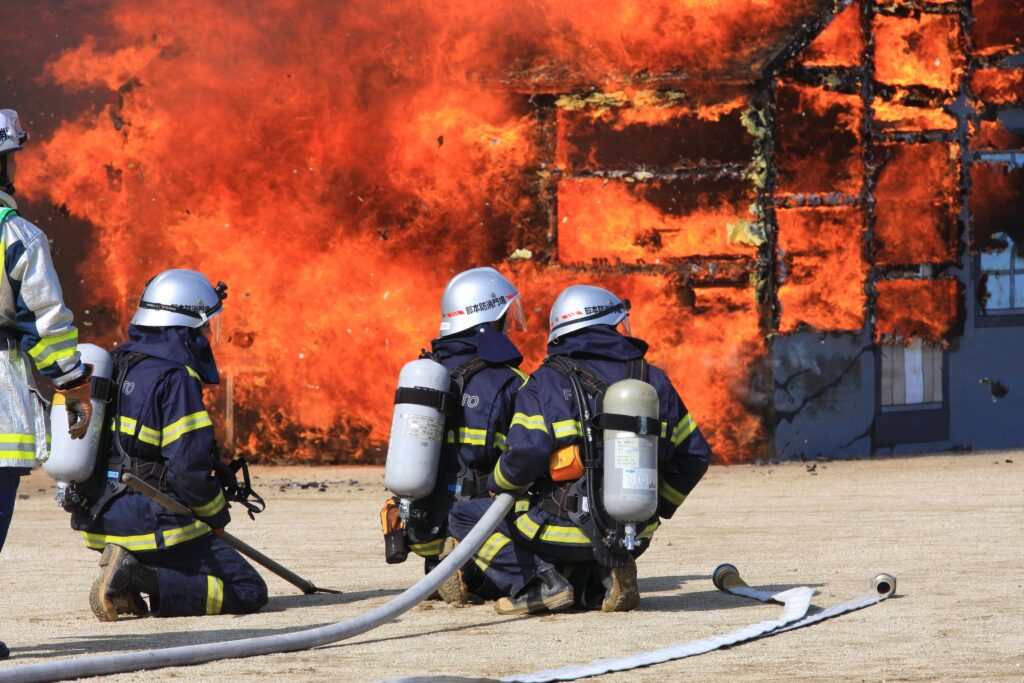
What Causes House Fires?
- The majority of house fires reported globally are Class F.
- Leaving the kitchen while cooking is the leading cause of house fires.
- Over 90% of house fires are preventable.
- 69% of house fires in the US between 2013 and 2017 occurred in one or two-family homes (duplexes or other multi-family housing).
- The number of house fire injuries and fatalities in 2018 was 43% lower than in 1980 in the US.
- House fires caused by careless smoking are the deadliest.
- Most people die in house fires because they were asleep when the fire broke out.
How do house fires start?
Nearly 50% of all house fires globally start in the kitchen. Common reasons include leaving the stove unattended or placing flammable objects close to the heat source.
The Top 10 Causes of House Fires
These are some of the most common causes of house fires:
Cooking – Leaving the food on a stove unattended is the most common cause of house fires.
Heating appliances – Placing a heater too close to curtains or laundry can cause a fire and substantial property damage.
Smoking – Failing to put out a cigarette before falling asleep can start a house fire with a fatal outcome.
Home appliances – Old toasters, microwaves, and similar appliances can start a fire if they’re left near a paper towel roll or other flammable items.
Faulty electrical installations – A frayed wire or a damaged socket can spark and cause a fire.
Candles – Forgetting to put out a candle before going to bed or leaving a home causes around 2% of house fires annually.
Inadequately stored flammable liquids – Paints, fuels, or adhesives can easily catch fire if they’re not stored properly.
Barbeques – Using a barbeque too close to a house or failing to clean it properly can cause a fire-related incident in a home.
Letting children play with fire – Curious children with access to matches, lighters or other sources of flame can lead to a house fire.
Arson – Unfortunately some fires are deliberate, with criminals looking to cause damage or commit fraud and claim insurance.
What causes the most house fires?
Kitchen accidents are the leading cause of house fires, the majority of which take place between 5 to 8 PM when most people return from work and prepare dinner. Cookers, toasters and similar kitchen appliances are often the cause of house fires.
What percentage of house fires are arson?
Roughly 10% of house fires in the UK are arson.
9% of house fires reported between 2016 and 2020 were started intentionally, according to the NFPA. Fire departments in the US respond to around 52,260 deliberate dwelling fires per year.
How many house fires occur each year?
The annual number of house fires varies by country. In the US, the annual average is 358,300, while 35,000 house fires take place in the UK every year.
How many house fires are caused by candles?
Most fires in residential structures caused by candles occur during the Christmas holidays, and 36% of all fire incidents related to candles start in bedrooms.
In the UK, more than 1000 candle fires occur every year. 4% of house fires in the US between 2018 and 2022 were caused by candles and fire departments across the nation responded to 5,910 fires started by candles during that period.
What causes electrical house fires?
Electrical house fires can start in many ways, with sources ranging from extension cords to fuse boxes. Electrical installations in homes older than 25 years significantly increase the chances of house fires. Overloading sockets or leaving clothes dryers and similar appliances running while the house is empty also increase the risk of a fire breaking out.
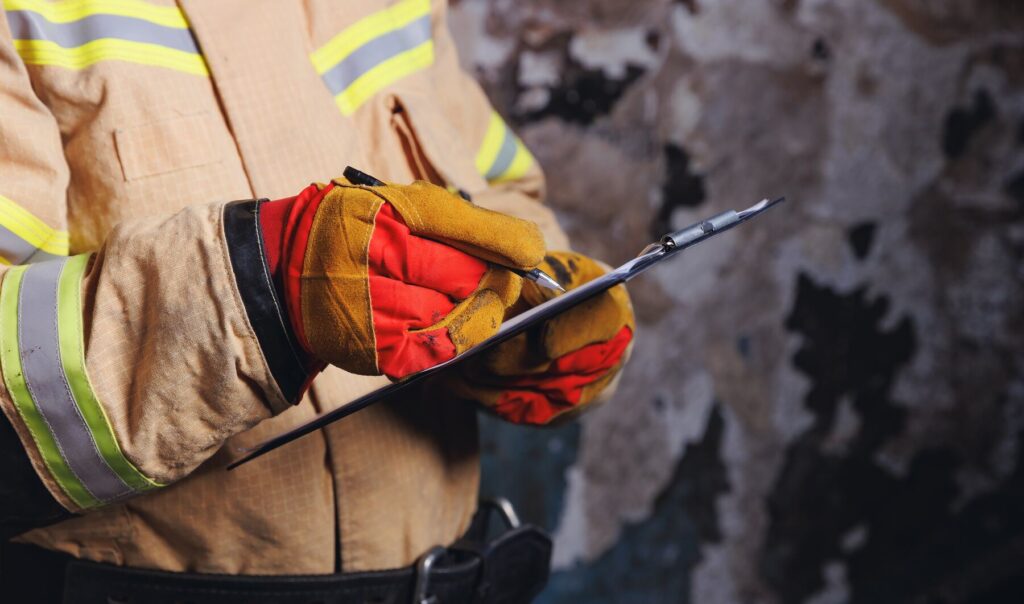
How many house fires are caused by hair straighteners?
Hair straighteners reach temperatures of over 200 Celsius and take around 40 minutes to cool down, so it makes sense why they have been the cause of approximately 650,000 house fires in the UK.
What percentage of house fires start in the kitchen?
60% of house fires in the UK start in the kitchen. In the US, the annual average number of house fires that start in the kitchen is 158,400 or 44% of the nation’s total house fires per year.
How many house fires are caused by Christmas trees?
The number of house fires in the US caused by Christmas trees has gradually decreased since the turn of the century. There were 380 house fires where the Christmas tree was the first material that ignited in 2000. In 2015, this number dropped to 170. House fires caused by Christmas trees are more common later in the holiday season, as over 40% of residential structure fires involving a Christmas tree occur in January.
Electrical House Fires Statistics
- Around 20,000 house fires start due to electrical issues every year in the UK.
- On average, fire departments in the US respond to 51,000 electrical house fires per year.
- 273,000 electrical home fires occur in the EU member states yearly.
- 24% of electrical house fires in the US reported between 2015 and 2019 occurred between 4 pm and 8 pm.
- 30% of electrical house fires happen during cold months (November – February).
- In 2021/22, 2,219 electrical house fires in the UK started due to faulty plugs, cables or wiring.
- 25% to 30% of all house fires in Europe start due to electrical issues.
- In the US, 68% of electrical house fires reported between 2015 and 2019 were caused by wiring and related equipment.
- Lighting equipment and electrical distribution systems were the causes of 32,160 electrical house fires in the US between 2015 and 2019.
How can electrical faults cause house fires?
Most electrical fires start because of electrical products – 9 in 10 electrical fires start in this way.
Faulty electrical installations can also cause fires, through ‘arcing’ – overheating or overloading the circuit. The heat damages the circuit and its connection to the bus, allowing the electricity to flow and igniting nearby combustible material. Damaged wiring, inadequately installed extension cords and power strips, malfunctioning home appliances or faulty power outlets can cause arcing and start a fire.
Do plug-in air fresheners cause house fires?
Air fresheners were the cause of 1,900 house fires in the US from 2010 to 2021. In most cases, plug-in air fresheners cause house fires because they’re connected to an overloaded circuit, but their bulbs can also overheat and set fabric they come in contact with on fire.
How many house fires are caused by electrical faults?
Thousands of house fires are caused by electrical faults worldwide every year. 15% of house fires in England and Wales are caused by electrical faults, and faulty electrical products cause 89% of the UK’s electrical house fires. The NFPA estimates that 50,000 house fires break out in the United States due to electrical issues.
How many house fires are caused by dryers?
The annual average of house fires caused by clothes dryers and washing machines in the US between 2010 and 2014 was 15,970. 4% of all house fires in the US from 2014 to 2018 were caused by dryers, while the failure to clean the appliance was the common reason the fire broke out.
What appliance causes the most house fires?
The highest number of house fires in the UK are caused by kitchen appliances such as cookers, hot plates or microwaves. Stoves and ranges caused 61% of kitchen fires in the US from 2014 to 2018.
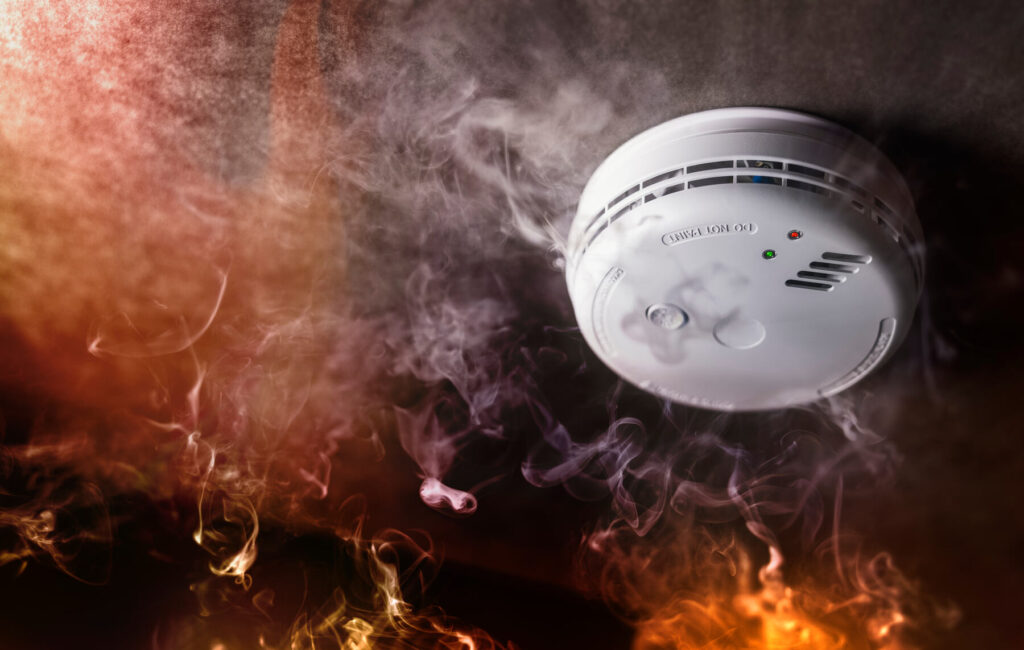
Smoking and House Fires
- The number of house fires caused by smoking in the US has decreased from 70,800 in 1980 to 16,500 in 2016.
- In the UK, someone dies from a fire caused by smoking materials every six days.
- Over 25% of all fire-related deaths in the UK from 2014 to 2018 were caused by smoking.
- Between 2012 and 2016, one in every 31 home fires caused by smoking materials in the US resulted in death.
- Older people with mobility issues are the most likely to die in house fires caused by smoking.
- From 2012 to 2016, rubbish, trash or waste was the most common first item to ignite in house fires started by smoking.
How many house fires are caused by smoking?
In the UK, smoking materials caused just 6% of house fires in 2016/2017, but they resulted in 36% of all home fire deaths during that period. 5% of all house fires in the US between 2012 and 2016 were caused by smoking materials. However, these home fires were the deadliest as they resulted in 590 fatalities, 23% of all deaths that occurred in house fires during this time.
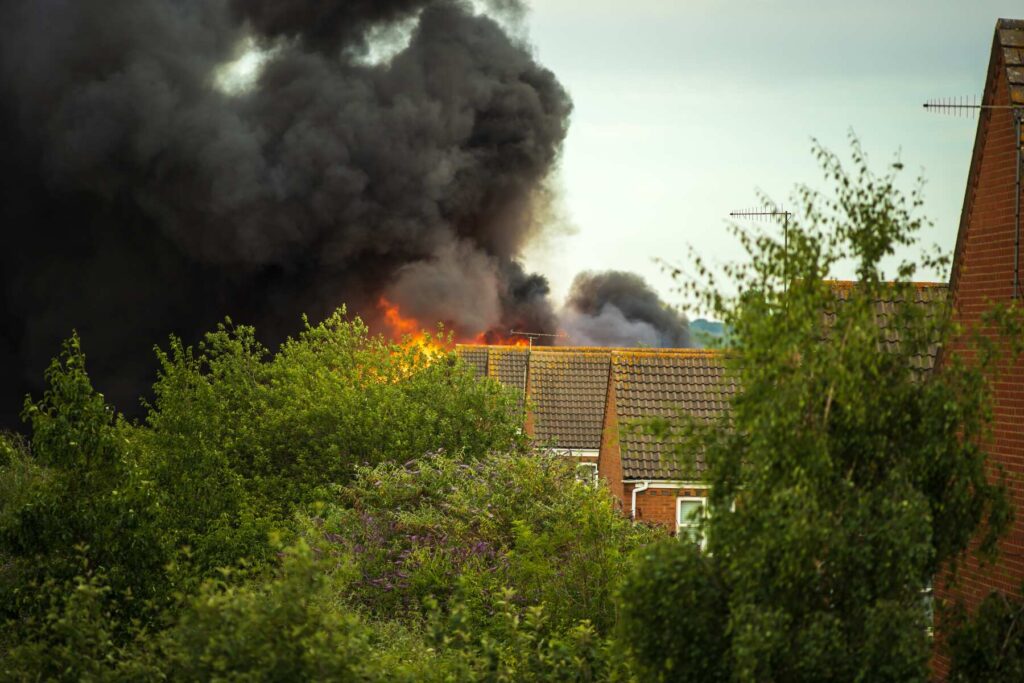
UK House Fire Statistics
The number of house fires in the UK has decreased over the last four decades. In 2023, the UK had the lowest annual number of house fires reported since 1981. Despite encouraging statistics, hundreds of people die or are injured in house fires every year.
- 9 mins 13 secs – the average total response time to primary fires in England in the year ending March 2023. That’s the longest average response time since comparable records became available.
- Average response times increased across all types of primary fires compared with the previous year. The largest increase was 1 mins 12 secs – in primary outdoor fires.
- In the year ending March 2023, there was an increase of 23 seconds in the average first appliance response time to primary fires compared to the previous year.
The number of house fires in 2023:
| England | Scotland | Wales |
| 592,996 | 99,532 | 37,427 |
- 14 people died in dwelling fire incidents in Wales in 2023, while Scotland had 32 house fire fatalities during the same period.
Average response time to fires, year ending March 2023
| Type of Fire | Year ending March 2023 | Year ending March 2022 | 1-Year Change | Year ending March 2018 | 5-Year Change | Year ending March 2013 | 10-Year Change |
| Primary fires | 9m 13s | 8m 50s | +23s | 8m 38s | +35s | 8m 04s | +1m 9s |
| Dwellings | 8m 00s | 7m 52s | +8s | 7m 48s | +12s | 7m 25s | +35s |
| Other buildings | 8m 56s | 8m 49s | +7s | 8m 27s | +29s | 7m 48s | +1m 8s |
How many house fires occur per year in the UK?
Firefighters attended more than 720,000 fire incidents in 2023 (year ending September 2023) across England (592,996), Scotland (99,532) and Wales (37,427).
What are the biggest causes of house fires in the UK?
Kitchen accidents cause the most house fires in the UK, while the misuse of equipment and leaving combustible materials too close to a heat source are also common reasons homes catch fire.
The main causes of dwelling fires in England in 2023:
| Cause | Number of incidents |
| Careless handling of fire or hot substances | 2,809 |
| Chip and fat pan | 1,182 |
| Deliberate | 2,736 |
| Faulty fuel supplies | 2,325 |
| Misuse of equipment or appliances | 7,051 |
| Faulty appliances and leads | 3,486 |
| Playing with fire | 211 |
| Placing articles too close to the heat source | 3,506 |
| Other accidental causes of fire | 3,484 |
How common are house fires in the UK?
Even though the annual number of house fires in the UK has steadily decreased over the last few decades, Fire and Rescue Services responded to 26,491 house fire calls in 2022/2023. These numbers indicate that a house fire breaks out in the UK every twenty minutes.
How many people die in house fires in the UK?
In 2023, the UK had 218 dwelling fire fatalities, while 265 people died in fire-related incidents during that time.
What are the biggest causes of house fires in the UK?
Kitchen accidents cause the most house fires in the UK, with appliance misuse or malfunction, and leaving combustible materials too close to a heat source also common reasons homes catch fire.
What percentage of house fires are caused by rodents in the UK?
Between 20% and 40% of unexplained house fires in the UK are caused by rodents. Rats and mice chew through the home’s electrical installations, often causing short circuits that provide the spark that starts the fire.
How many house fires are caused by candles in the UK?
Candles cause around 3% of all house fires in the UK every year, resulting in approximately 6% of all home fire injuries and 3% of dwelling fire fatalities. Forgetting to put out a candle before going to bed or leaving home is the most common reason house fires caused by candles break out.
The number of home fire safety checks in the UK in 2017/2018:
| Number of Home Fire Safety Checks carried out by FRS | Number of HFSCs carried out by FRS: People aged 65 years and over | Number of HFSCs carried out by FRS: Disabled People |
| 576,077 | 316,017 | 146,464 |
Wales
- 39% of all primary fires reported in Wales in 2023 were dwelling fires, a 3% decrease from the year before.
- Welsh Fire and Rescue Services attended 6,164 fires between April and September 2023.
- During the same period, there were 2,175 primary fires in Wales and 3,394 secondary fires.
- 25 fewer people needed first aid, were sent to hospital or advised to seek medical advice in April-September 2023 compared to the same period in 2022.
- In 2022-23, Welsh Fire and Rescue Services attended 3% more fires than the previous year.
- Fires attended in Wales have been on a downward trend over the last 20 years – 2022-23 saw 69% fewer fires attended than 2001-02.
Scotland
- Scottish Fire and Rescue Services conducted 36,738 home fire safety visits in 2023/24 – over the last 5 years, 6.6% of all Scottish households were visited.
- Just 16.1% of home fire safety visits conducted in 2023/24 had fire alarms installed.
- In 2017/18, Scotland had 8.1 fire fatalities per million of the population – in comparison, England had 6.0 and Wales 4.8.
- There were 372 deliberate building fires in Q1 2023/24, slightly more than the 370 in the same period the previous year.
Northern Ireland
- The number of house fires has increased by 14% from 2022 to 2023, including 8 deaths.
- 39% of accidental house fires in 2020/21 occurred in homes where the person lived alone.
- 435 accidental dwelling fires in 2019 had an electrical origin, accounting for 58% of all accidental dwelling fires that year.
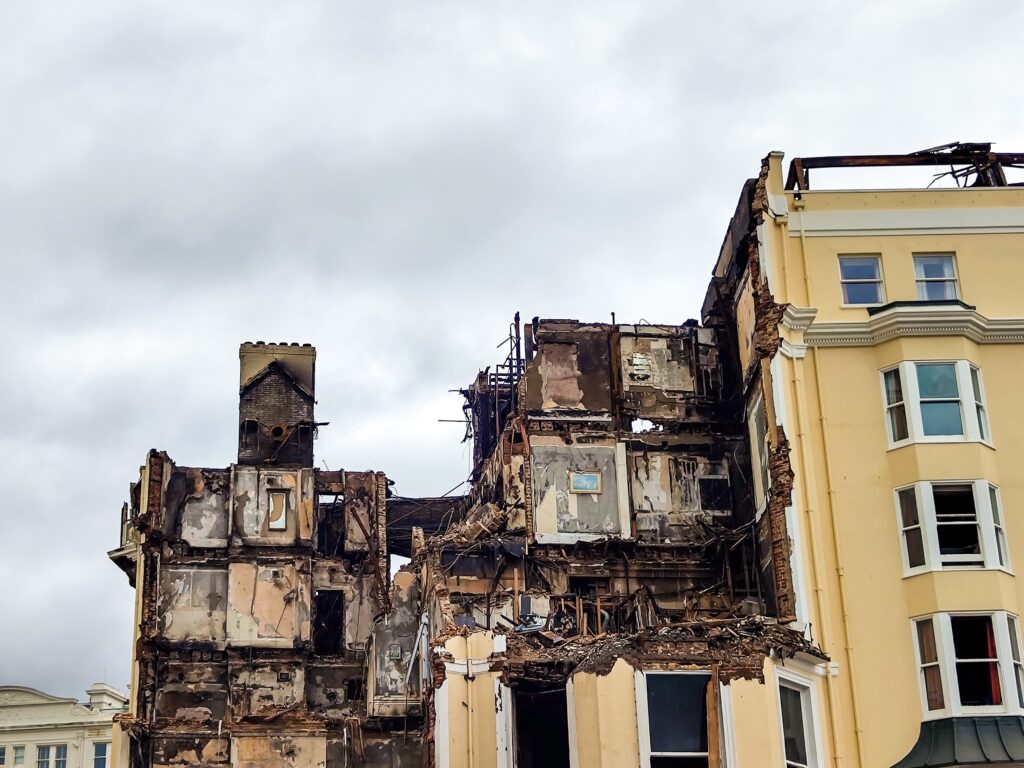
US House Fire Statistics
- An average of 358,000 house fires occur in the US every year.
- As of March 2024, 567 people had died in fire-related incidents in the US since the beginning of the year.
- The majority of the fire fatalities (77.3%) in the US occur in residential properties.
- The national average of deaths in house fires was 6.5 per 1,000 fires, while the average number of injuries in house fires is 20.9 per 1,000 fires.
- Men die or get injured in house fires more frequently than women. In 2021, over 60% of all house fire victims were male.
- Residential fires accounted for 25% of all fires reported in the US in 2022.
- The annual number of house fires in the US has decreased from 1980 to 2022.
- In 2020, the percentage of people falling asleep with a fire burning in the fireplace decreased by 64%.
- In 2023, just 1% of all calls to the LA Fire Department were to report a structure fire.
- 24,359 structure fires were reported to the NYFD in 2021.
A study of 14 Western US states identified areas where the residences are at the highest risk of fire. Just 3 states make up 70% of the risk:
California:
- Los Angeles-Long Beach-Anaheim (242,188 residences)
- Riverside-San Bernardino-Ontario (212,921 residences)
- San Diego-Chula Vista-Carlsbad (153,999 residences)
- Sacramento-Roseville-Folsom (102,291 residences)
- San Francisco-Oakland-Berkeley (92,824 residences)
Texas:
- Austin-Round Rock-Georgetown (91,961 residences)
- San Antonio-New Braunfels (71,795 residences)
- Killeen-Temple (12,702 residences)
- Dallas-Fort Worth-Arlington (5,567 residences)
- Waco (2,636 residences)
Colorado:
- Denver-Aurora-Lakewood (69,287 residences)
- Colorado Springs (51,321 residences)
- Fort Collins (14,692 residences)
- Boulder (9,781 residences)
- Pueblo (3,242 residences)
How many house fires occur each day in the United States?
Over 1,000 fires occur in the United States every day, killing seven Americans and injuring hundreds more. The majority of these incidents take place in homes that don’t have smoke alarms or other fire prevention equipment.
How many house fires are caused by deep frying turkeys?
Over a thousand deep fryer fires occur every year in the United States, causing five deaths, 25 injuries and over $26 million in property loss. House fire incidents involving deep frying turkeys are the most common on Thanksgiving Day. Fire departments in the US responded to 1,160 house fire calls on this day in 2021.
Impact of House Fires
Thousands of people die in house fires worldwide every year, while many more are injured. The statistics show that house fires pose a greater threat to older people due to limited mobility and the inability to prevent the fire from spreading in a timely manner.
- 2,620 people died every year from 2015 to 2019 in house fires, while 11,070 were injured in the US.
- Over 5,000 people die in house fires in Europe every year.
- 57% of people who died in house fires between 2015 and 2019 in the US were male.
- Most people who die in house fires caused by smoking materials are older than 55.
- In 2021/22, 334 people died in house fires in the UK.
- 193 house fires had a fatal outcome in England during 2022/2023.
- On average, roughly 50,000 homes ignite due to electrical faults every year in the US, causing approximately 400 deaths.
- In the US, one person dies in a house fire every 144 minutes.
The economic impact of house fires
Statistics for 2023 show that approximately $9 billion worth of property is damaged or destroyed in house fires in the US every year. The average loss for US homeowners in a fire or lightning incident was $83,991 between 2017-2021.
Preventing House Fires
The data indicates that over 90% of house fires are preventable, while the vast majority of dwelling fires are accidental.
- Three out of five house fire fatalities occur in homes that don’t have a functioning smoke alarm.
- Staying in the kitchen while cooking significantly reduces the risk of house fire.
- Checking the home’s electrical installations periodically can lower the risk of an electrical house fire.
- 96% of homes in the US have a smoke alarm.
Sources
Ready.gov, American Red Cross, PrepareCenter, NFPA, Fire & Rescue New South Wales, First Alert, US Fire Administration, FireTrace International, Firefighter Now, SafeWise, National Fire Protection Association, San Francisco Fire Department, Firefighter Insider, UK Government, Colorado River Fire & Rescue, Statista, The Zebra, This Old House, CBC, FEMA, FDNY Smart, Western Disaster Cleanup, ResearchGate, Worth Insurance, Connecticut State Commission on Fire Prevention and Control, National Safety Council, Reader’s Digest Canada, UK-Fire Risk Assessment, NIIDirect, NSC, Library of the European Parliament, International Association of Fire and Rescue Services, Office of the Illinois State Fire Marshal, London Fire Brigade, European Fire Safety Alliance, Hippo, Electrical Safety First, Fire Safe Living, Fire Cash Buyers, 247 Home Rescue, Proelectrical, Electrical Safety Foundation, South Yorkshire Fire & Rescue, Envista Forensics, Family Safety & Health Magazine, Gitnux, Safety Culture, Griff Electric, Industrial Safety & Hygiene News, FireTrace International, VHL Facilities, Electrical Direct, Servicemaster Restore, Devon and Somerset Fire and Rescue Service, Forbes, Bankrate, Insurance Claim HQ, American Phychology Association, National Library of Medicine, Scottish Fire and Rescue Service, FireCloud365, Northern Ireland Fire and Rescue Service, Welsh Government, Scottish Government, Electrical Safety First, Fire & Electrical Safety, Royal Berkshire Fire and Rescue Service, Humberside Fire & Rescue Service, The Hartford, FDNY Smart, Universety of Rochester Medical Center, FireServ, Fire Equipment Manufacturers’ Association, National Institute of Standards and Technology, Animal Emergency Care, CoreLogic, BRE

